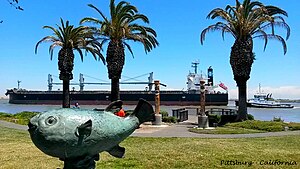Pittsburg, California
|
City of Pittsburg (formerly) Black Diamond and New York of the Pacific |
|
|---|---|
| City | |
 |
|
| Nickname(s): "P-World" "The Burg" | |
| Motto: Gateway to the Delta! | |
 Location in Contra Costa County and the state of California |
|
| Location in the United States | |
| Coordinates: 38°01′41″N 121°53′05″W / 38.02806°N 121.88472°WCoordinates: 38°01′41″N 121°53′05″W / 38.02806°N 121.88472°W | |
| Country | United States |
| State | California |
| County | Contra Costa |
| Incorporated | June 25, 1903 |
| Government | |
| • Type | General Law City |
| • Mayor | Marilyn Craft |
| • State Senator | Steve Glazer (D) |
| • State Assembly |
Jim Frazier (D) and Tim Grayson (D) |
| • U. S. Congress | Mark DeSaulnier (D) |
| Area | |
| • Total | 19.154 sq mi (49.610 km2) |
| • Land | 17.218 sq mi (44.595 km2) |
| • Water | 1.936 sq mi (5.015 km2) 10.11% |
| Elevation | 26 ft (8 m) |
| Population (2010) | |
| • Total | 63,264 |
| • Density | 3,300/sq mi (1,300/km2) |
| Time zone | PST (UTC-8) |
| • Summer (DST) | PDT (UTC-7) |
| ZIP code | 94565 |
| Area code(s) | 925 |
| FIPS code | 06-57456 |
| GNIS feature IDs | 1659783, 2411430 |
| Website | www |
Pittsburg is an industrial city in Contra Costa County, California. The population was 63,264 at the 2010 census. It is located on the southern shore of the Suisun Bay in the East Bay region of the San Francisco Bay Area.
In 1849, Colonel Jonathan D. Stevenson (from New York) bought the Rancho Los Medanos land grant, and laid out a town he called New York of the Pacific. By 1850, this venture failed. With the discovery of coal in the nearby town of Nortonville, California, the place became a port for coaling, and adopted the name Black Diamond, after the mining firm that built the Black Diamond Coal Mining Railroad from there to Nortonville. Because of the industrial potential of the site, a name change to Pittsburg was proposed in 1909.
Pittsburg, originally settled in 1839, was called first "New York Landing", then "Black Diamond", before citizens voted on "Pittsburg" on February 11, 1911. The name was selected to honor Pittsburgh, Pennsylvania, as the two cities' shared a common steel and mining industrial heritage. However, from 1891 to July 1911, Pittsburgh, PA was officially known as "Pittsburg", following a country-wide standardization of geographical names by the United States Board on Geographic Names. Hence, in February 1911, when Pittsburg, CA adopted it name, the 'h' was absent from its namesake city. Five months later, after an appeals process lasting almost two decades, Pittsburgh, Pennsylvania won a rare reversal and the 'h' was restored to the city's official name, which persists to this day, resulting in the spelling difference.
The original town site fronts on the Sacramento/San Joaquin River Delta, reflecting its origins as a deep water channel river port. (As of January 1, 2007, state legislation [Assembly Bill 2324] enabled the city to manage its own riverfront for commercial development and subsequent port operations). Since the early 1900s, the city has grown inland to the south, then spread east and west along State Route 4, now a freeway carrying resident commuters to jobs in the San Francisco Bay-Oakland Region. In the process, the former town of Cornwall, California was absorbed. The city has enjoyed continued residential redevelopment growth near its northern boundary, as well as ongoing construction of major subdivisions in the southwest hills, including San Marco Villas. As of the 2000 census, the city had a total population of 56,769.
...
Wikipedia

